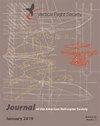Deep Learning Based Obstacle Awareness from Airborne Optical Sensors
IF 1.4
4区 工程技术
Q2 ENGINEERING, AEROSPACE
引用次数: 0
Abstract
Aviation statistics identify collision with terrain and obstacles as a leading cause of helicopter accidents. Assisting helicopter pilots in detecting the presence of obstacles can greatly mitigate the risk of collisions. However, only a limited number of helicopters in operation have an installed helicopter terrain awareness and warning system (HTAWS), while the cost of active obstacle warning systems remains prohibitive for many civil operators. In this work, we apply machine learning to automate obstacle detection and classification in combination with commercially available airborne optical sensors. While numerous techniques for learning-based object detection have been published in the literature, many of them are data and computation intensive. Our approach seeks to balance the detection and classification accuracy of the method with the size of the training data required and the runtime. Specifically, our approach combines the invariant feature extraction ability of pretrained deep convolutional neural networks (CNNs) and the high-speed training and classification ability of a novel, proprietary frequency-domain support vector machine (SVM) method. We describe our experimental setup comprising the CNN + SVM model and datasets of predefined classes of obstacles—pylons, chimneys, antennas, TV towers, wind turbines, helicopters—synthesized from prerecorded airborne video sequences of low-altitude helicopter flight. We analyze the detection performance using average precision, average recall, and runtime performance metrics on representative test data. Finally, we present a simple architecture for real-time, onboard implementation and discuss the obstacle detection performance of recently concluded flight tests.基于深度学习的机载光学传感器障碍物感知
航空统计表明,与地形和障碍物的碰撞是直升机事故的主要原因。协助直升机驾驶员探测障碍物的存在可以大大降低碰撞的风险。然而,只有有限数量的直升机在操作中安装了直升机地形感知和预警系统(HTAWS),而主动障碍物预警系统的成本对于许多民用运营商来说仍然是令人望而却步的。在这项工作中,我们将机器学习应用于与商用机载光学传感器相结合的自动障碍物检测和分类。虽然文献中已经发表了许多基于学习的目标检测技术,但其中许多技术都是数据和计算密集型的。我们的方法旨在平衡方法的检测和分类精度与所需训练数据的大小和运行时间。具体来说,我们的方法结合了预训练深度卷积神经网络(cnn)的不变特征提取能力和一种新颖的专有频域支持向量机(SVM)方法的高速训练和分类能力。我们描述了我们的实验设置,包括CNN + SVM模型和预定义障碍物类别的数据集-塔,烟囱,天线,电视塔,风力涡轮机,直升机-从低空直升机飞行的预先录制的机载视频序列合成。我们使用代表性测试数据上的平均精度、平均召回率和运行时性能指标来分析检测性能。最后,我们提出了一个简单的实时、机载实现架构,并讨论了最近完成的飞行测试的障碍物检测性能。
本文章由计算机程序翻译,如有差异,请以英文原文为准。
求助全文
约1分钟内获得全文
求助全文
来源期刊

Journal of the American Helicopter Society
工程技术-工程:宇航
CiteScore
4.10
自引率
33.30%
发文量
36
审稿时长
>12 weeks
期刊介绍:
The Journal of the American Helicopter Society is a peer-reviewed technical journal published quarterly (January, April, July and October) by AHS — The Vertical Flight Society. It is the world''s only scientific journal dedicated to vertical flight technology and is available in print and online.
The Journal publishes original technical papers dealing with theory and practice of vertical flight. The Journal seeks to foster the exchange of significant new ideas and information about helicopters and V/STOL aircraft. The scope of the Journal covers the full range of research, analysis, design, manufacturing, test, operations, and support. A constantly growing list of specialty areas is included within that scope. These range from the classical specialties like aerodynamic, dynamics and structures to more recent priorities such as acoustics, materials and signature reduction and to operational issues such as design criteria, safety and reliability. (Note: semi- and nontechnical articles of more general interest reporting current events or experiences should be sent to the VFS magazine
 求助内容:
求助内容: 应助结果提醒方式:
应助结果提醒方式:


